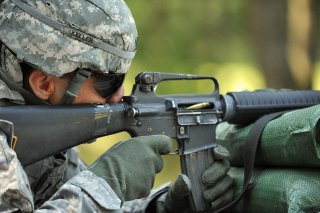Travis Pike

By the turn of the 20th century, most military forces had moved to centerfire, bolt-action rifles that were firing, what would be considered, small and fast cartridges. However, these rifles chambered centerfire cartridges that were often big, heavy, expensive, and labor-intensive to build. Further, a lot of machine work on these rifles was rudimentary, and hand-fitting was common. All these factors made them bad for training purposes. So cadet rifles came as the solution.
Cader rifles were offered as a cheaper and easier-to-produce alternative in a much cheaper caliber. Most cadet rifles mimicked the basic overall layout of the rifles of the era, however, they were chambered in .22LR which is a very small round that uses a rimfire design. These low-powered rounds are extremely cheap to produce and, even today, cost pennies.
AT THE RANGE WITH A CADET RIFLE
Cheap rifles and cheap ammo mean that a military can inexpensively teach marksmanship skills to new shooters. It is also easier to train a new shooter with a round like .22LR. At the range, this cartridge has much less recoil than a full-powered rifle cartridge, it’s also substantially quieter. New shooters could focus on firearm safety and basic marksmanship rather than concern themselves with recoil and massive booms. Instructors could more easily pass information with the report of a .22 rifle than with that of a .30 caliber battle rifle.
The US used several rifles for that purpose, most famously the M1922, which was a bolt action .22LR rifle designed to mimic the Springfield M1903 rifle. It also used bolt-action rifles from Remington, Stevens, and Winchester for marksmanship training long after the semi-auto M1 Garand had been the rifle of choice.
The Germans had a similar idea with the Mauser KKW cadet rifle, another .22LR rifle designed to mimic the Karabiner 98K. The British and Australians have one of the earlier known cadet rifles in the form of the Martini Cadet, which mimicked the Martini-Henry and used a unique .310 Cadet cartridge. America seems to have the first with the Remington M1867 in .50-45 centerfire carbine cartridge
These types of rifles taught new shooters the ins and outs of the rifle they would likely carry into combat. Yet, several cadet rifles were just used for training purposes. These rifles did not mimic a specific rifle but were issued only to teach marksmanship to troops.
Modern cadet rifles also exist and are chambered in larger calibers. The Parker-Hale M82 is used by the British to this day to teach new shooters basic marksmanship and it uses a 7.62 NATO round. Another modern cadet rifle is the L98A1 which uses a 5.56 round as well and is a single-shot mock-up of the British L85 rifle.
THE DOWNSIDES TO CADET RIFLES
The main downside, especially with a rimfire variant of an actual rifle, is that the trainee still needs to learn how to handle a full-powered cartridge as the minimal recoil generated by a .22LR does not truly prepare a troop to handle a battle rifle.
Further, while cheaper in the short run, a cadet rifle still requires you to train armorers, instructors, and soldiers on a platform that won’t be sued in battle which creates additional logistical requirements. Modern manufacturing has also made it much cheaper to produce ammunition and rifles. This is largely why your modern troop is trained with the same rifle they’ll carry into combat.
Cadet rifles have largely disappeared in most military forces, but you could argue the air rifles and rimfire rifles used by NJROTC and ROTC teams are a cadet rifle’s modern incarnation.
No comments:
Post a Comment